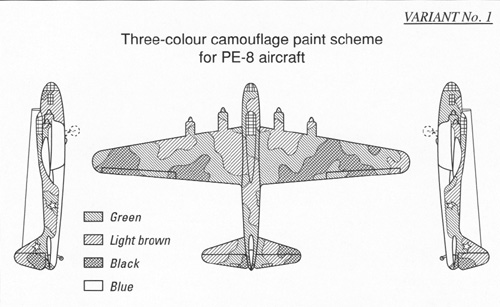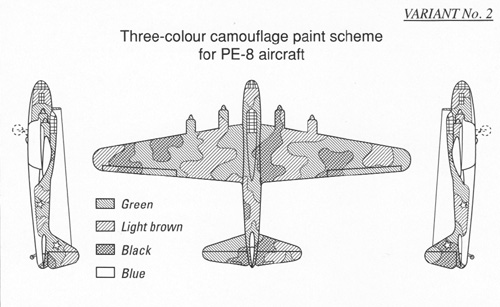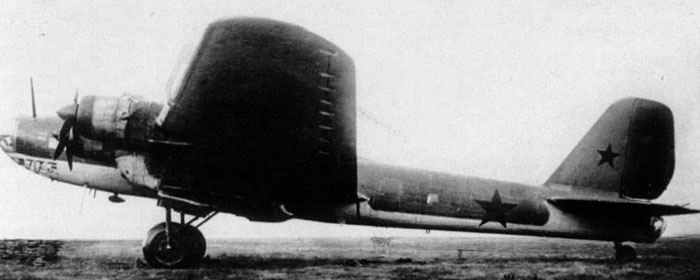
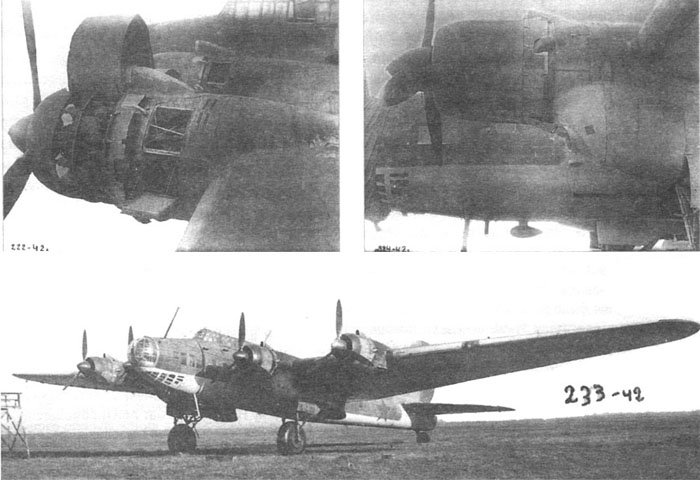
The first installation of ASh-82 engines on Pe-8s was made in 1942, on planes s/n 42047 and 42058 only.
This was a choice due both to the easier availability of this, both to its higher power and less fuel consumption,
In facts, the supply of AM-35A engines were scarce because the factory had to build the similar AM-38F engines for Il-2s with an higher priority.
The radial engine was not only more available, but more powerful and with a lower fuel consumption, allowing the range (with 2000 kg payload) to increase from 3500 km of Mikulin-engined planes to 5000 km .
All the 18 Pe-8s built in 1943 were equipped with ASh-82 engines, as well as 14 planes of 18 built in 1944 (the last four ones being equipped with ACh-30B diesel engines, that were improved and more reliable than their brothers of 1940/41).
The new engine had shortcomings too: it has a complex throttle control that caused some accidents during takeoff: an uneven increase in power during takeoff could cause the plane to veer off, damaging the landing gear; in 1943 alone, 6 planes were lost in such accidents.
Besides the flight altitude was reduced and the flames from exhausts were more visible because of the lack of flame-damping exhausts, making the night bombers more vulnerable to AA fire and fighters.
The photos aside are of plane 42047 that, after the completion of the test flights, crashed after the take-off from the factory 124 airfield for the delivery flight to the operative unit.

Plane s/n 42059, personal aircraft of general M. Vodopiyanov, probably in winter 1942/43. Note the the light leading edges, equipped with a de-icing system and not yet repainted in camouflage color, that show their yellowish primer finish.
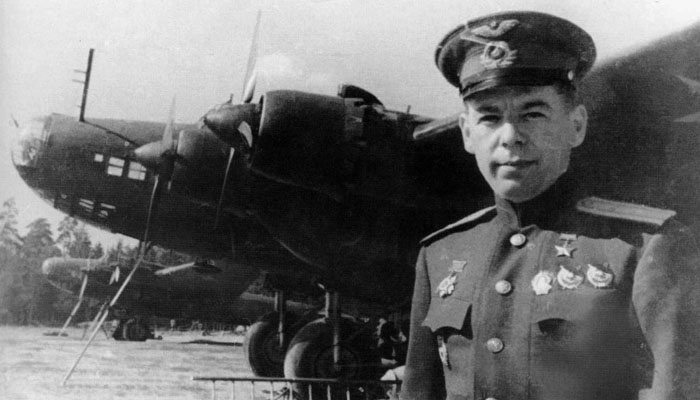
Pe-8 ASh-82 of pilot Simonov in 1943. The early ASh-82 engined planes had the same turret of earlier AM-35 engined planes, and the same style of camouflage and markings.
The directive n°2389/0133 of July 3, 1943, gave new instructions to paint the Soviet warplanes:
- upper and side surfaces of all types of aircraft but fighters had to be camouflaged in green, light brown and dark grey (black for Il-4 and Pe-8);
- the red stars remained in the same six positions of before, but were addictioned with a thick white outline and, more externally, with a further thin red outline.
- the directive applied to new planes and those in repair shops; it wasn't required that operative units repainted all their planes.
All metal planes would have employed oil paints:
- Light brown A-21m
- dark green A-24m
- Black A-28m or dark grey A-32m
- again Nach deep black for the undersides.
Drawings from 'Colors of the falcons' of Hornat and Migliardi
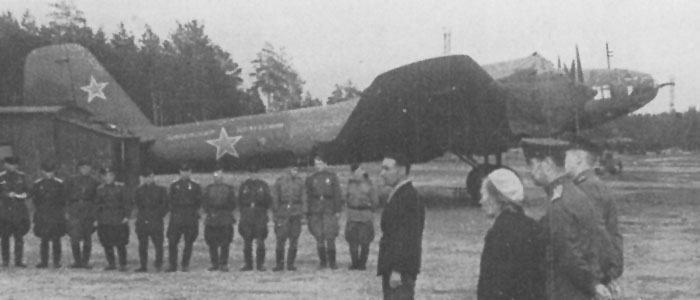
From the few photos available, Pe-8s seem to have painted with scarce respect to the standard templates.
This plane with AM-82 engines shows a very vague resemblance to the 1st template, but the lack of a light brown band on the rear fuselage is noticeable. The use of dark grey instead of black on the upper camo is likely, due to the scarce contrast of the bands while the 'noch' on undersurfaces is clearly distinguishable.
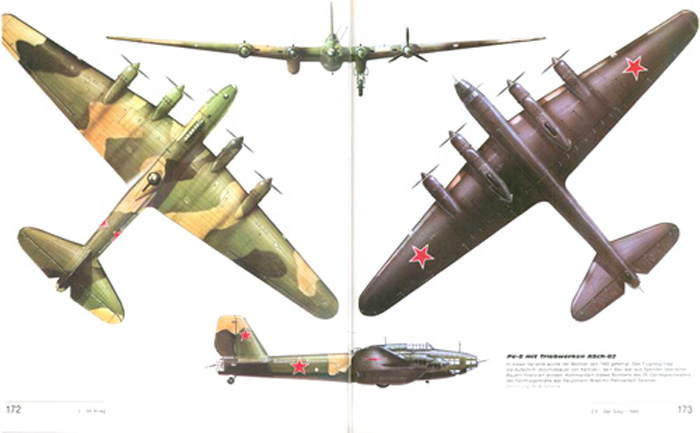
Drawing of Pe-8 from Pe-8-der Sowjetische fernbomber of Ulrich Unger.
It is clearly a reconstruction made on the base of the previous photo, where possible, and of the standard templates for the remaining uppersurfaces.


Above: plane 42511, flown by the commander Guards Major
Makarenko, made a forced landing on January 8, 1944 due to an engine
misfunction.
The camouflage is hardly recognizable, anyway it is likely of the green/grey/brown type with black undersurfaces.
http://heavybomber.narod.ru/_42511.htm
Left: A bomb FAB-2000 lies on the ground close to a Pe-8. Note the turret on the nose.
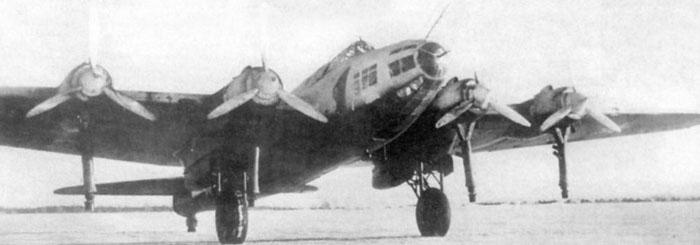
Pe-8 AL-82RN heating pipes installed under the engines, probably during the winter 1943-44.
This plane is interesting for its full winter finish. Note the new shape of the nose, without turret.

Pe-8 4M-82 s/n 42109, 42049 and 42058 were lost in the 'Massacre of s. Bartholomew' on the night of 21th July 1943, during the Battle of Kursk, when the 45th Air Division ADD made a raid over a railway junction. Two of them were shot down by Bf-110 night fighters, the other one by the Flak.
http://heavybomber.narod.ru/_VF_NIght.htm
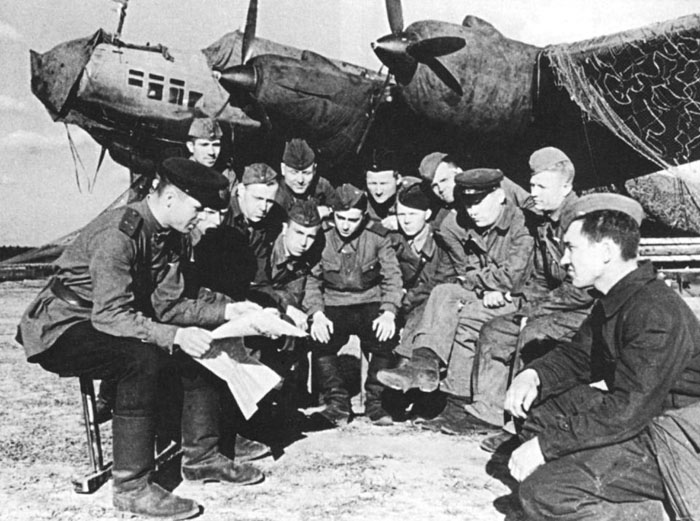
Some Pe-8s were employed for the night raids on Helsinki of February 1944:
PE-8s/n 4210 Red 1 of 25 Gv.AP DD flown by N.A Ishenko dropped a 5000 kg bomb on the first night.
PE-8s/n 42910, Light blue 13 of 890 AP DD flown by captain A.J Shamaraj dropped a 5000 kg bomb on the first night;
On the third mission of the night of february 26/27 PE-8 ASh 82 s/n
421010, pilot A.S.Ugrjumov was shot down. Six parachutes were seen,
but none survived.
The last sortie of Pe-8 as long range bomber was made on August 1944, then they were utilized for other duties, as transport planes, because they had become obsolete and an easy pray for more modern German interceptors.
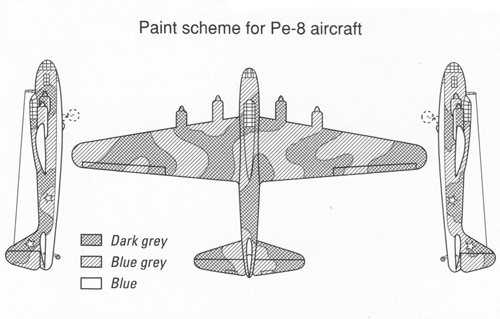
In late 1944 the Soviet Air Force had already reached a position of superiority over the German Luftwaffe and its alleys. While Germans reverted to green/brown camouflages to hide better their planes on the ground, the Soviets decided to extend to all planes the blue grey/dark grey camouflage that has been successful for fighters since August 1943.
On October 1, 1944, the Resolution n.6339 was approved, but burocratic delays retarded its publication till January 1945.
The prescribed colors for all metal planes were oil enamels:
- blue-grey A-33m
- dark grey A-32m
- light blue A-28m
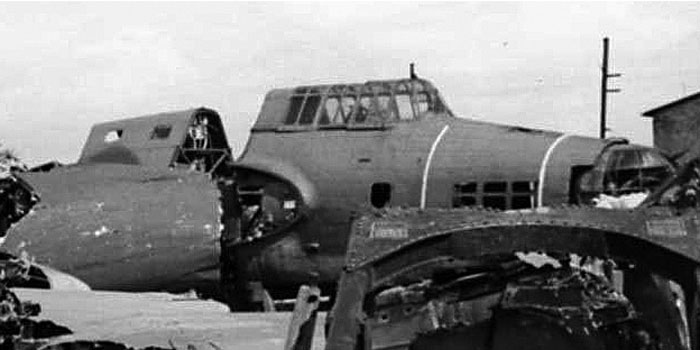
No any photographic evidence does exist of the application of this livery on any Pe-8 (that had been put out of production in 1944).
Anyway, the Pe-8ON passengers plane wore a livery with the upper and side surfaces of one color, that some sources suggest to be blue-grey A-33m, while other sources suggest green.
Here is a photo of a Pe-8 of early type in a demolition facility in the early '50s. The uppersurfaces could give the idea of a solid colour, apart for the dark blotch visible on the trunk of the central fuselage.
